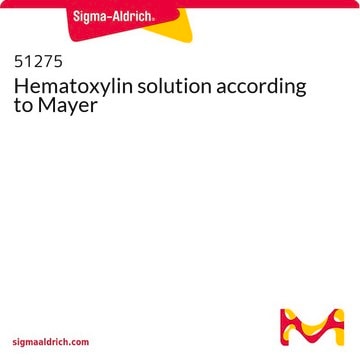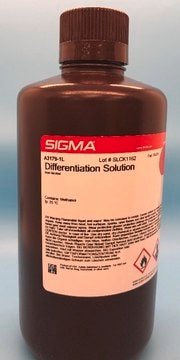03971
Hematoxylin solution according to Delafield
for microscopy
Synonim(y):
Delafield’s hematoxylin
About This Item
Polecane produkty
klasa czystości
for microscopy
Poziom jakości
linia produktu
BioChemika
Postać
liquid
metody
microbe id | staining: suitable
zanieczyszczenia
ammonium alum
methanol
gęstość
0.950-1.044 g/mL at 20 °C
Zastosowanie
diagnostic assay manufacturing
hematology
histology
temp. przechowywania
room temp
przydatność
Chlamydia spp.
Histoplasma spp.
Plasmodium spp.
Trichomonas spp.
bacteria
protozoa
spirochetes
ciąg SMILES
Oc1cc2C[C@@]3(O)COc4c(O)c(O)ccc4[C@H]3c2cc1O
InChI
1S/C16H14O6/c17-10-2-1-8-13-9-4-12(19)11(18)3-7(9)5-16(13,21)6-22-15(8)14(10)20/h1-4,13,17-21H,5-6H2/t13-,16+/m0/s1
Klucz InChI
WZUVPPKBWHMQCE-XJKSGUPXSA-N
Powiązane kategorie
Opis ogólny
Zastosowanie
Hasło ostrzegawcze
Danger
Zwroty wskazujące rodzaj zagrożenia
Zwroty wskazujące środki ostrożności
Klasyfikacja zagrożeń
Acute Tox. 4 Oral - Flam. Liq. 3 - STOT SE 1
Organy docelowe
Eyes,Central nervous system
Kod klasy składowania
3 - Flammable liquids
Klasa zagrożenia wodnego (WGK)
WGK 3
Temperatura zapłonu (°F)
107.6 °F - closed cup
Temperatura zapłonu (°C)
42 °C - closed cup
Środki ochrony indywidualnej
Eyeshields, Faceshields, Gloves, type ABEK (EN14387) respirator filter
Choose from one of the most recent versions:
Masz już ten produkt?
Dokumenty związane z niedawno zakupionymi produktami zostały zamieszczone w Bibliotece dokumentów.
Klienci oglądali również te produkty
Nasz zespół naukowców ma doświadczenie we wszystkich obszarach badań, w tym w naukach przyrodniczych, materiałoznawstwie, syntezie chemicznej, chromatografii, analityce i wielu innych dziedzinach.
Skontaktuj się z zespołem ds. pomocy technicznej










